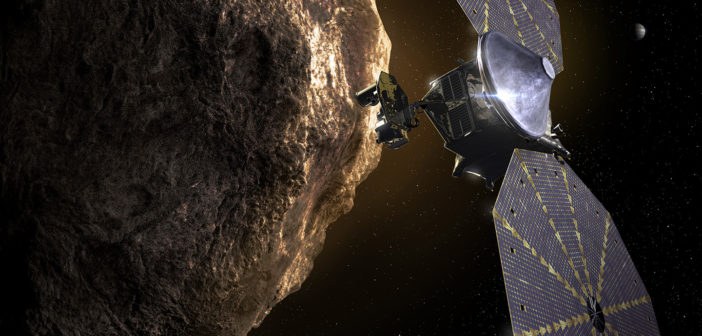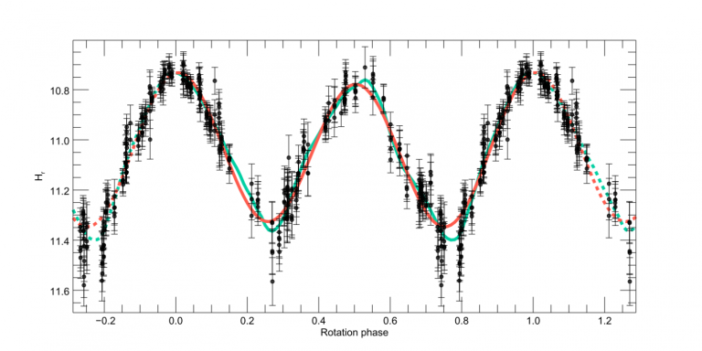Editor’s note: Astrobites is a graduate-student-run organization that digests astrophysical literature for undergraduate students. As part of the partnership between the AAS and astrobites, we occasionally repost astrobites content here at AAS Nova. We hope you enjoy this post from astrobites; the original can be viewed at astrobites.org.
Title: Light Curves of Lucy Targets: Leucus and Polymele
Author: Marc W. Buie, Amanda M. Zangari, Simone Marchi, Harold F. Levison, Stefano Mottola
First Author’s Institution: Southwest Research Institute
Status: Published in AJ
Asteroids, meteoroids, meteors, meteorites. Usually when we talk about these small chunks of debris and rock in the solar system, it’s about another possible apocalypse scenario. Studies of rocky objects that may pass near Earth’s orbit (near-Earth objects, or NEOs) are of obvious importance for the safety of humanity, but they are only one minor subset of the small bodies in our solar system. Most of the asteroids in our neighborhood live in the Asteroid Belt, a region between the orbits of Mars and Jupiter, and they’re referred to as “main-belt asteroids”. There are also large populations trailing Jupiter in its orbit (the Trojan asteroids) and floating out in the outer solar system near Neptune (the Centaur asteroids).
But apart from the potential threat posed by NEOs, why study these plentiful, seemingly uninteresting hunks of rock and metal that we will likely never encounter on Earth? It turns out that they actually serve as an important window into the formation of the solar system, providing us with information on how the planets formed and what our early solar system was made of. Since we have the chance to get up close and personal with the planets and asteroids nearest to us with rovers and other probes, scientists use this information to infer how other planetary systems form as well. In recent history, we’ve visited most of the major planets with satellites, such as Voyager or Cassini, or rovers, such as Curiosity on Mars; however, the smaller debris is still largely unexplored. The New Horizons mission provided a glimpse into icy debris in the outer solar system when it imaged Pluto and a Kuiper-Belt object (2014 MU69) in detail for the first time, and both NASA’s OSIRIS-REx and JAXA’s Hayabusa missions are working on returning samples from near-Earth asteroids.
A new asteroid mission has begun preparation as well, targeting multiple asteroids in the further-out Trojan group near Jupiter. The Lucy Discovery mission plans to visit multiple Trojans (actually, the largest number of independently orbiting objects ever visited by a single probe), including Leucus and Polymele, whose flybys are scheduled for September 2027 and April 2028 respectively. Until that date, though, astronomers are busy preparing for the mission and trying to gather all the data on these objects that we can from Earth. The authors specifically investigate Leucus and Polymele, using their light curves to tease out information about their color, composition, orbit, and reflectivity.

Figure 1: Lucy’s planned orbital path, illustrating the location of the Trojans in Jupiter’s orbit. [SwRI]
For Leucus and Polymele, this research group used telescopes in the Las Cumbres Global Telescope Network (LCOGT), specifically two telescopes at Cerro Tololo in Chile and one at MacDonald Observatory in the United States. These images were taken in the red part of the spectrum of visible light, since asteroids tend to be brighter at longer wavelengths. After taking multiple data images over time, the results of the brightness of the asteroid vs. time are plotted into a light curve, as shown in Figure 2.
Through their observations of Leucus, the team determined that it has a very long rotation period, and it may actually be a binary system. Future observations from the ground will be needed to determine if it is or not. If it is a binary, this can provide scientists with even more information about when it formed; in the early solar system, when more debris was flying around, it would have been easier to form a binary than it is now. From its colors, Leucus is also determined to be a “primitive” asteroid; this type of asteroid is very dark (even darker than coal!), and may be relevant to the question of how life began on Earth because they are thought to carry organic, carbon-rich material. Unfortunately, this paper reports that Polymele is still not well-understood — likely because it is so small and might be nearly spherical, providing very little variation in its light curve. It’s also extremely dark, though not as dark as Leucus.Although these may seem like small steps at first — determining characteristics of one or two rocks in the vast solar system — they are actually stepping stones (literally!) to understanding the population of asteroids that surrounds us. Asteroids may be what brought life to Earth, and they are intact remnants of the story of planet formation. The key to a successful space mission is minimizing risk, and a large component of that is knowing what you’re getting into when you’re millions of miles away in space; studying these asteroids will prevent the spacecraft from encountering physical hazards (like collisions), and will inform what data we need to take in-situ to better understand them. By studying the future targets of the Lucy mission now, the lander, and the humans running the mission, will be prepared for its eventual encounter with them.
About the author, Briley Lewis:
Briley Lewis is a first-year graduate student and NSF Fellow at the University of California, Los Angeles studying Astronomy & Astrophysics. Her research interests are primarily in planetary systems — both exoplanets and objects in our own solar system, how they form, and how we can create instruments to learn more about them. She has previously pursued her research at the American Museum of Natural History in NYC, and also at Space Telescope Science Institute in Baltimore, MD. Outside of research, she is passionate about teaching and public outreach, and spends her free time bringing together her love of science with her loves of crafting and writing.


1 Comment
Pingback: AAS Nova – New